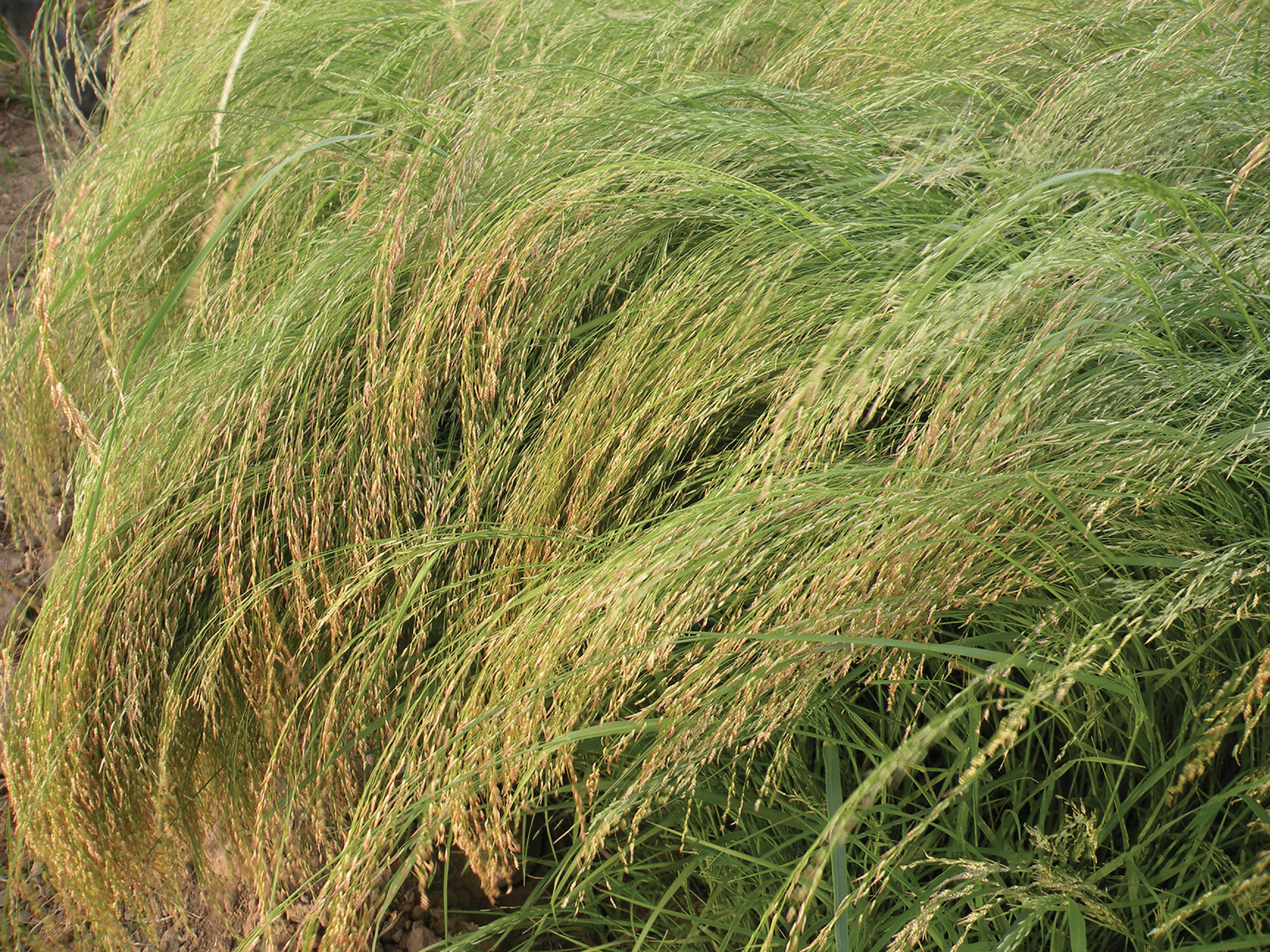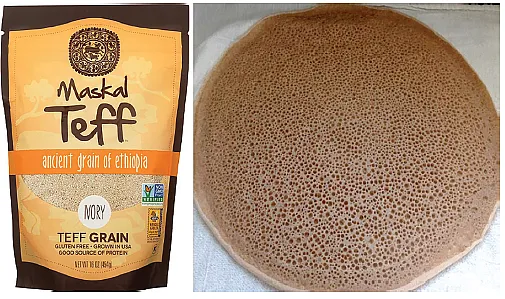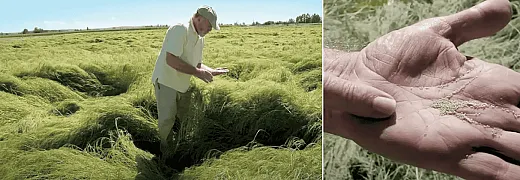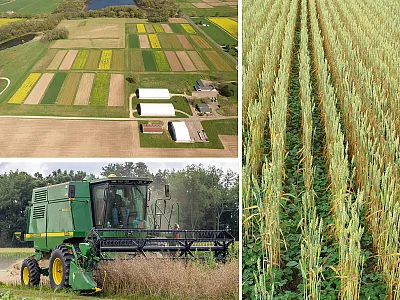Teff: Food for the Future


Teff (Eragrostis tef) is a native Ethiopian grain crop that is gaining popularity in the United States as a nutritious grain and a high quality forage crop. It is a reliable low-risk crop that is relatively resistant to biotic and abiotic stresses and can be grown under moisture stress or waterlogged conditions. While it has a lot of potential, more research and education on teff is needed, particularly in the area of breeding and in the cropʼs nutrient and water requirements. Earn 0.5 CEUs in Crop Management by reading this article and taking the quiz at https:// web.sciencesocieties.org/Learnig-Center/Courses.
The current world population of more than 7 billion is expected to hit 9 billion by 2050. Meeting the food demand of this continuously growing population continues to be a challenge as hunger is on the rise. According to The Food and Agriculture Organization of the United Nations (FAO), nearly 9% of the world population has suffered from hunger in 2019. In 2020, COVID‐19 impacts have led to an increase in global food insecurity, affecting not just the under‐developed but almost every country. A sustainable solution is needed before the world faces food emergency.
Globally, humanity depends on a very limited number of crop species for fulfilling a basic human dietary diet. Maize, wheat, and rice have been the principal crops grown throughout the world for centuries. Currently, these crops are providing about 60% of total food requirement. This dependence limits our ability to deal with food insecurity and dietary imbalance. A sensible solution to this would be exploring underutilized crop species that can meet our dietary needs and enhance nutritional security.
Teff (Eragrostis tef) is a native Ethiopian grain crop originating between 4000 and 1000 B.C. It is gaining popularity in the United States as a nutritious grain and a high quality forage crop. The nutritionally packed teff grain contains 9–11% protein, 80–85% carbohydrates, 73% starch, and 4.4% lipids. The majority of teff lipids were found to be unsaturated, which is important for a healthy diet. These fats help to reduce risk of heart disease and lower cholesterol levels. Teff grain also contains substantial levels of vitamins A, B, and C and major essential amino acids such as leucine, valine, proline, alanine, and glutamic and aspartic acids. Compared with other cereal grains, teff is richer in iron, calcium, zinc, and magnesium (Table 1). The absence of gluten and gluten‐free proteins makes teff popular among individuals suffering from celiac disease (gluten intolerance). Teffʼs slow‐release carbohydrate constituents make it useful for diabetic patients. Teff grain is also rich in bran, an important source of fiber.
Sources: Agren & Gibson, 1968; Bultosa & Taylor, 2004; FAO, 1992; Gebremariam et al., 2014; Hager & Arendt, 2013; Juliano, 1993; Ketema, 1987; Michaelsen et al., 2011; Mossé et al., 1985; Shoup et al., 1969; USDA-ARS, 2014; Wolter et al., 2013.
Teff grain is ground into flour, used to make cakes, biscuits, cookies, bread, muffins, and pasta. Teff is best known for its use in making injera, a spongy Ethiopian flatbread. It is also used for brewing gluten‐free lactic‐acid beverages. Apart from serving as a healthy food source for humans, teff is preferred as a forage crop by animals, especially horses. It can be grown for dry hay, silage, or pasture. Additionally, teff grain is used to produce antioxidants and fat replacers.

Growing Teff
Teff is a reliable low‐risk crop. It is relatively resistant to biotic and abiotic stresses and can be grown under moisture stress or waterlogged conditions. Its short production cycle makes it useful as a rescue or catch crop in areas with limited water availability when perennials have failed. Growing teff as a double crop, green manure crop, cover crop, or even an emergency crop when unfavorable weather conditions delay planting of other grain crops is an excellent option. Teff is often grown as an economically viable rotational crop thatʼs compatible with a variety of commodity crops. Its shallow root system makes crop rotation following teff relatively easy and efficient. As there are no teff‐specific nutrient management guidelines for Idaho, growers are generally following wheat fertilizer recommendations. Planting teff after crops with high nutrient demands like potatoes and sugarbeets is a sensible way to utilize the nutrients left over in the soil after previous harvest.
Compared with other cereal crops, disease and pest problems have been seldom observed in teff. Weeds are a major problem in teff production as there are only a handful of herbicides that are approved for its weed management. Planting teff early and controlling weeds at the start of the season helps to maintain the teff fields free of weeds once the teff canopy closes. Harvesting and handling of teff can be challenging due to its minute grain size. With a length of 0.9–1.7 mm and width of 0.7–1 mm, 150 teff grains’ weight equals that of just one wheat grain. In Africa, teff is primarily traditionally threshed with the help of sheep and then harvested by hand; significant grain loss is a common occurrence at harvest. U.S. farmers typically swath the teff grain at maturity followed by combining once dried.
| Nutrient | Teff | Maize | Sorghum | Wheat | Rice |
|---|---|---|---|---|---|
| Energy (kcal) | 357 | 375 | 370 | 359 | 357 |
| Starch (%) | 73 | 72 | 63 | 71 | 64 |
| Crude protein (%) | 11 | 8–11 | 8.3SS | 11.7 | 7.3 |
| Amino acid (g/16 g N) | |||||
| Lysine | 3.7 | 0.3 | 2.1 | 3.7 | |
| Isoleucine | 4.1 | 0.7 | 3.7 | 4.5 | |
| Leucine | 8.5 | 2.1 | 7.0 | 8.2 | |
| Valine | 5.5 | 0.8 | 4.1 | 6.0 | |
| Phenylalanine | 5.7 | 0.9 | 4.9 | 5.5 | |
| Tyrosine | 3.8 | 0.7 | 2.3 | 5.2 | |
| Tryptophan | 1.3 | 0.2 | 1.1 | 1.2 | |
| Threonine | 4.3 | 0.5 | 2.7 | 3.7 | |
| Histidine | 3.2 | 0.4 | 2.1 | 2.3 | |
| Arginine | 5.2 | 0.6 | 3.5 | 8.5 | |
| Methionine | 4.1 | 0.3 | 1.5 | 2.7 | |
| Cystine | 2.5 | 0.3 | 2.4 | 1.8 | |
| Asparagine | 6.4 | 5.1 | 9.0 | ||
| Serine | 4.1 | 0.8 | 5.0 | 5.0 | |
| Glutamine + glutamic acid | 21.8 | 29.5 | 17.0 | ||
| Proline | 8.2 | 1.3 | 10.2 | 5.0 | |
| Glycine | 3.1 | 0.5 | 4.0 | 4.5 | |
| Alanine | 10.1 | 1.6 | 3.6 | 5.5 | |
| Crude fat (%) | 2.5 | 4.9 | 3.9 | 2 | 2.2 |
| Total polyunsaturated fatty acids | 1.1 | 1.8 | 1.4 | 0.5 | 0.8 |
| Linoleic acid (LA) | 0.9 | 1.7 | 1.3 | 0.5 | 0.78 |
| α-linoleic acid (ALA) | 0.14 | 0.05 | 0.07 | 0.03 | 0.03 |
| Crude fiber (%) | 3.0 | – | 0.6 | 2.0 | 0.6–1.0 |
| Total dietary fiber | 4.5 | 2.6 | – | ||
| Soluble dietary fiber | 0.9 | 0.6 | – | ||
| Ash (%) | 2.8 | 1.4 | 1.6 | 1.6 | 1.4 |

Further Reading
“Teff (Eragrostis tef) Processing, Utilization, and Further Opportunities: A Review,” by Roselle Barretto, Rania Marie Buenavista, Jared Lou Rivera, Shuyu Wang, P. V. Vara Prasad, and Kaliramesh Siliveru “Teff, A Rising Global Crop: Current Status of Teff Production and Value Chain,” by Hyejin Lee “Teff Grass Crop Overview and Forage Production Guide: A Guide for Producers, Extension, Educators and Seed Marketers,” by Don Miller
Teff, a warm‐season crop, grows poorly in cold temperatures and dies in freezing temperatures. The climate of Idahoʼs Snake River Valley (hot summers and intense sunlight) is remarkably similar to that of East Africa where teff originates. This makes Idaho the perfect place to grow teff. With fertile soils and ecologically sensitive farming practices, some of the best quality teff in the world is produced in Idaho.
Growing teff as a double crop, green manure crop, cover crop, or even an emergency crop when unfavorable weather conditions delay planting of other grain crops is an excellent option.
Teff Market
According to DataM Intelligence, the world teff market is expected to grow by 19.3% by 2027. Globally, Ethiopia and Eritrea are the leading teff producers followed by Europe, Asia‐Pacific, South America, and North America. Currently, teff is grown in at least 25 U.S. states. The Teff Company is the leading producer of teff in Idaho. The company started growing and marketing teff since the early 1980s and works closely with the growers in the U.S., especially the Pacific Northwest. Farmers deliver the grain to the Teff Companyʼs Boise, ID facility. There, the grain is cleaned, processed into flour, and packaged. According to Gareth Carlson, the operations manager at The Teff Company, the teff flour has high market demand, and the company is continuously expanding its network of grower‐cooperators. Idaho teff producers mainly grow two varieties: brown and ivory. Brown teff has a strong nutty flavor while ivory is milder and sweeter.
For several reasons (small flower size and niche markets), practically no work has been done in the area of breeding/selecting teff varieties in the U.S. More research and education on teff is needed, particularly in the area of breeding/variety selection and nutrient and water requirements of the crop. In addition, mechanization will be required to minimize grain loss at harvest and handling. Researchers in the Cropping Systems Agronomy Program at the University of Idaho, Parma, are excited about future collaborative research in these areas.
References
Agren, G., & Gibson, R.S. (1968). Food composition table for use in Ethiopia. Swedish International Development Authority, Stockholm, and Ethiopian Nutrition Institute, Addis Ababa.
Bultosa, G., & Taylor, J.R.N. (2004). Teff. In H. Corke, C.E. Walker. & Wrigley, C. (Eds.), Encyclopedia of grain science (pp.281–289). Academic Press.
FAO (Food and Agriculture Organization of the United Nations). (1992). Maize in human nutrition. FAO.
Gebremariam, M.M., Zarnkow, M., & Becker, T. (2014). Teff (Eragrostis tef) as a raw material for malting, brewing and manufacturing of gluten‐free foods and beverages: a review. Journal of Food Science and Technology, 51, 2881–2895 (2014). https://doi.org/10.1007/s13197‐012‐0745‐5
Hager, A.‐S., & Arendt, E.K. (2013). Influence of hydroxypropylmethylcellulose (HPMC), xanthan gum and their combination on loaf specific volume, crumb hardness and crumb grain characteristics of gluten‐free breads based on rice, maize, teff and buckwheat. Food Hydrocolloids, 32(1), 195–203.
Juliano, B.O. (1993). Rice in human nutrition. International Rice Research Institute.
Ketema, S. (1997). Tef, Eragrostis tef (Zucc.) Trotter (Promoting the Conservation and Use of Underutilized and Neglected Crops Series No. 12). Gatersleben: Institute of Plant Genetics and Crop Plant Research & Rome: International Plant Genetic Resources Institute.
Michaelsen, K.F., Dewey, K.G., Perez‐Exposito, A.B., Nurhasan, M., Lauritzen, L., & Roos, N. (2011). Food sources and intake of N‐6 and N‐3 fatty acids in low‐income countries with emphasis on infants, young children (6–24 months), and pregnant and lactating women. Maternal & Child Nutrition, 7(S2), 124–140.
Mossé, J., Huet, J.C., & Baudet, J. (1985). The amino acid composition of wheat grain as a function of nitrogen content. Journal of Cereal Science, 3(2), 115–130.
Shoup, F.K., Deyoe, C.W., Campbell, J., & Parrish, D.B. (1969). Amino acid composition and nutritional value of milled sorghum grain products. Cereal Chemistry, 46(2), 164–171.
USDA‐ARS. (2014). USDA National Nutrient Database for Standard Reference, Release, 27. http://www.ars.usda.gov/ba/bhnrc/ndl
Wolter, A., Hager, A.‐S., Zannini, E., & Arendt, E.K. (2013). In vitro starch digestibility and predicted glycemic indexes of buckwheat, oat, quinoa, sorghum, teff and commercial gluten‐free bread. Journal of Cereal Science, 58(3), 431–436.
Self-Study CEU Quiz
Earn 0.5 CEUs in Crop Management by taking the quiz for the article at https://web.sciencesocieties.org/Learning-Center/Courses. For your convenience, the quiz is printed below. The CEU can be purchased individually, or you can access as part of your Online Classroom Subscription.
- Teff contains substantial amounts of:
- Gluten.
- Bran.
- Saturated lipids.
- Sodium.
- Which of the following is a major problem in teff production?
- Moisture stress.
- Pests.
- Disease.
- Weeds.
- How do teff and wheat grain compare in weight?
- 150 teff grains = 1 wheat grain.
- 100 wheat grains = 1 teff grain.
- 300 teff grains = 1 wheat grain.
- 200 wheat grains = 1 teff grain.
- Which teff variety is known for its strong nutty flavor?
- Ivory.
- Gold.
- Brown.
- Red.
- Which of the following is a known problem in teff production, according to the article?
- Grain loss at harvest.
- Seeding at the right depth.
- Crop establishment.
- Long production cycle.
Text © . The authors. CC BY-NC-ND 4.0. Except where otherwise noted, images are subject to copyright. Any reuse without express permission from the copyright owner is prohibited.










